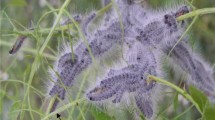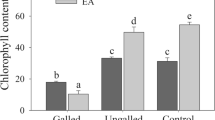Abstract
Hypersensitivity is known as a localized resistance of plants against pathogens. It also can be detected in response to galling insects, i.e., in the area immediately adjacent to the site of oviposition and attempted penetration by the galling larva. This host response includes morphological and histological changes that cause the death of the attacked tissue. It is observed as a rounded dark brown halo around the gall induction site. We provide the first observation on the occurrence and possible relevance of this induced mechanism by which one of the most common tree species in Germany, Fagus sylvatica L., resists attack by two of its most common galling insects, Mikiola fagi and Hartigiola annulipes (Diptera: Cecidomyiidae). Galls induced by these cecidomyiids were extremely common in the studied area in beech forests around Darmstadt, Germany. The availability of resources (leaves on a stem) was a poor predictor of attack by the galling insects as well as for gall abundance (galls successfully formed). Hypersensitive reaction was the most important factor acting against the galling population studied. More than 77% of the attempts of the insects to induce galls on F. sylvatica resulted in failure and consequently the death of the galling larvae. Therefore, few live galls remained to be found and destroyed by natural enemies. This corroborates the view that in galling insect–host plant system interactions plant-driven factors may play a major role in determining herbivore failure and success, and perhaps the resulting community structure.


Similar content being viewed by others
References
Agrawal AA (1988) Induced responses to herbivory and increased plant performance. Science 279:1201–1202
Baldwin IT (1988) Jasmonate-induced responses are costly but benefit plants under attack in native populations. Proc Natl Acad Sci USA 95:8113–8118
Bentur JS, Kalode MB (1996) Hypersensitive reaction and induced resistance in rice against the Asian rice gall midge Orseolia oryzae. Entomol Exp Appl 78:77–81
Boysen Jensen P (1948) Formation of galls by Mikiola fagi. Physiol Plant 1:95–108
Boysen Jensen P (1952) Untersuchungen über die Bildung der Galle von Mikiola fagi. Dan Biol Medd 18:1–18
Buhr H (1965) Bestimmungstabellen der Gallen (Zoo- und Phytocecidien) an Pflanzen Mittel- und Nordeuropas. Vol. II. Fischer, Jena
Cornelissen TG, Fernandes GW (1999) Plant hypersensitivity against tissue invasive insects: Bauhinia brevipes and Contarinia sp. interaction. In: Csóka G, Mattson WJ, Stone GN, Price PW (eds) The biology of gall inducing arthropods. US Department of Agriculture, Forest Service, North Carolina, pp 144–152
Cornelissen TG, Fernandes GW (2001a) Defense, growth, and nutrient allocation in Bauhinia brevipes (Leguminosae)? Aust Ecol 26:246–253
Cornelissen TG, Fernandes GW (2001b) Induced defenses to herbivory: effects of damage-induced changes on leaf quality and insect herbivore attack. Trees 15:236–241
Cornelissen TG, Madeira BG, Allain LR, Lara ACF, Araújo LM,Fernandes GW (1997) Multiple responses of insect herbivores to plant vigor. Cienc Cult 49:285–288
Cornelissen TG, Negreiros D, Fernandes GW (2002) Plant resistance against gall-forming insects: the role of hypersensitivity. In: Wagner M (ed) Mechanisms and deployment of resistance in trees to insects. Kluwer, Amsterdam, pp 135–150
Dziurznski A (1961) The inhabitants of the galls of Mikiola fagi HTG. I. Materials for the morphology and development of Mikiola fagi HTG. (Itonididae), as well as of its endophagous primary parasite Secondes coactus RATZB. (Chalcididae). Acta Zool Cracov 2:9–49
Faria ML, Fernandes GW (2001) Vigor of a dioecious shrub and attack by a galling herbivore. Ecol Entomol 26:37–45
Fernandes GW (1987) Gall forming insects: their economic importance and control. Rev Bras Entomol 31:379–398
Fernandes GW (1990) Hypersensitivity: a neglected plant resistance mechanism against insect herbivores. Environ Entomol 19:1173–1182
Fernandes GW (1998) Hypersensitivity as a phenotypic basis of plant induced resistance against a galling insect (Diptera: Cecidomyiidae). Environ Entomol 27:260–267
Fernandes GW, Negreiros D (2001) The occurrence and effectiveness of hypersensitive reaction against galling herbivores across host taxa. Ecol Entomol 25:46–55
Fernandes GW, Price PW (1992) The adaptive significance of insect gall distribution: survivorship of species in xeric and mesic habitats. Oecologia 90:14–20
Fernandes GW, Cornelissen TG, Isaias RMS, Lara AF (2000) Plants fight gall formation: hypersensitivity. Cienc Cult 52:49–54
Garza R, Vera J, Cardona, C, Barcenas N, Singh SP (2001) Hypersensitive response of beans to Apion godmani (Coleoptera: Curculionidae). Environ Entomol 94:958–962
Gonçalves-Alvim SJ, Fernandes GW (2001) Biodiversity of galling insects: historical, community and habitat effects in the neotropical savanna. Biodivers Conserv 10:79–98
Gonçalves-Alvim SJ, Faria ML, Fernandes GW (1999) Relationships between four neotropical species of galling insects and shoot vigor. Ann Soc Bras Entomol 28:147–155
Karban R (1993) Costs and benefits of induced resistance and plant density for a native shrub, Gossypium thurberi. Ecology 74:9–19
Karban R, Baldwin IT (1997) Induced responses to herbivory. The University of Chicago Press, Chicago
Karban R, Agrawal AA, Thaler JS, Adler LS (1999) Induced plant responses and information content about risk of herbivory. Trends Ecol Evol 14:443–447
Kirst GO (1974) Zur Physiologie der Galle von Mikiola fagi Htg. auf Blättern von Fagus sylvatica L. 3. 14CO2-Licht- und Dunkelfixierung der Galle. Biochem Physiol Pflanz 165:457–466
Kirst GO, Rapp H (1974) Zur Physiologie der Galle von Mikiola fagi Htg. auf Blättern von Fagus sylvatica L. 2. Transport 14C-markierter Assimilate aus dem befallenen Blatt und aus Nachbar-blättern in die Galle. Biochem Physiol Pflanz 165:445–455
Larson KC, Whitham TG (1991) Manipulation of food resources by a gall-forming aphid: the physiology of sink-source interactions. Oecologia 88:15–21
Pehl L, Butin H (1994) Endophytishe Pilze in Blättern von Laubbäumen und ihre Beziehungen zu Blattgallen (Zoocecidien). Mitt Biol Bundesanst Land Forstwirtsch Berlin-Dahlem 297
Rapp H, Kirst GO (1974) Zur Physiologie der Galle von Mikiola fagi Htg. auf Blättern von Fagus sylvatica L. 1. Vergleichende Untersuchungen einiger Inhaltsstoffe der Galle und des Blattes. Biochem Physiol Pflanz 165:437–444
Rohfritsch O, Shorthouse JD (1982) Insect galls. In: Kahl G, Schell JS (eds) Molecular biology of plant tumors. Academic Press, New York, pp 131–152
Shukle RH, Grover PB Jr, Mocelin G (1992) Responses of susceptible and resistant wheat associated with Hessian fly (Diptera: Cecidomyiidae) infestation. Environ Entomol 21:845–853
Tuomi JP, Niemelä P, Rousi M, Sirén S, Vuorisalo T (1988) Induced accumulation of foliage phenols in mountain birch: branch response to defoliation? Am Nat 132:602–608
Wold EN, Marquis RJ (1997) Induced defense in white oak: effects on herbivores and consequences for the plant. Ecology 78:1356–1369
Acknowledgements
This investigation was supported by the programme PROBRAL from Fundação Coordenação de Aeprfeiçoamento de Pessoal de Nível Superior, Brazil, and Deutscher Akademischer Austauschdienst, Germany. G.W.F. thanks the CNPq (521772/95–8) and Fapemig (CRA 2519/97) for partial support. We thank AR Lima for field and laboratory help.
Author information
Authors and Affiliations
Corresponding author
Rights and permissions
About this article
Cite this article
Fernandes, G.W., Duarte, H. & Lüttge, U. Hypersensitivity of Fagus sylvatica L. against leaf galling insects. Trees 17, 407–411 (2003). https://doi.org/10.1007/s00468-003-0252-4
Received:
Accepted:
Published:
Issue Date:
DOI: https://doi.org/10.1007/s00468-003-0252-4




